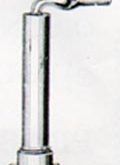Originally published in The British Medical Journal on March 6, 1886.
Sir,

In the Journal of February 27th, appeared a short article giving an account of the results obtained by Horn, working under the direction of Professor FOrster, of Amsterdam, with the Pasteur-Chamberland filter. As the reader might gather from the concluding lines of your article, that some difficulties attend the use of this filter, I venture to correct a possible misconception. This admirable invention appears to me to realize pratically the ideal of a filter, for it removes all living forms and their germs, without affecting the chemical composition of the water. Having employed one of these filters in my house during the last three months, I have become convinced that they have only to be known in order to replace all other filters.
As was mentioned in your article, the water to be filtered is forced under pressure through a tube of unglazed porcelain, and in this process is so freed from organic germs that, as was first found by M. Pasteur, and confirmed by Dr. Percy Frankland, and by Horn, it is perfectly sterilized. In order to demonstrate the fact, the porcelain tube must, of necessity, be first sterilized by the action of heat, so as to destroy the germs accidentally adhering to the inside of the filter; and this is a procedure which can only be practiced by skilled persons provided with suitable appliances. Where pure water is needed for domestic purposes, however, this preliminary sterilization by heat is altogether unnecessary, for the object is to remove all germs which may accidentally have become mixed with it from the water which passes through; and this will be effected as perfectly by an unsterilized tube as by one which has been sterilized.
The quantity of water which passes through the tube, or tubes, of the Pasteur-Chamberland filters, depends upon:
- the texture and thickness of the unglazed porcelain, of which the tubes are constructed;
- the pressure of water;
- the deposition of organic and inorganic matters upon and within the outer layers of the porcelain tube.
The latter circumstance accounts for the fact that, after the filters have been in use for some time, the rate of filtration sensibly diminishes. When this occurs, say after two or three months, the porcelain tube shoudl be removed, a proceeding which can be effected in a few seconds, and then its outer surfaces rubbed with a hard brush, whilst water is allowed to flow over it from a tap; on replacing it in its former position, the process of filtration will go on as before.
The filter which I have is connected with a pipe supplying water to the butler’s pantry, and the pressure is that of a column of water nearly thirty feet high. After being in operation for nearly three months, the filter delivers at the rate of more than twenty-six pints of filtered water in twenty four hours.
–I am, sir, your, etc.,
St. Leonard’s-on-Sea. ARTHUR GAMGEE
 Pasteur Brewing Louis Pasteur – Science, Health, and Brewing
Pasteur Brewing Louis Pasteur – Science, Health, and Brewing 

